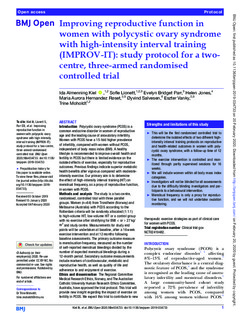| dc.contributor.author | Kiel, Ida Almenning | |
| dc.contributor.author | Lionett, Sofie Buurgaard | |
| dc.contributor.author | Parr, Evelyn B. | |
| dc.contributor.author | Jones, Helen | |
| dc.contributor.author | Røset, Maria Aurora Hernandez | |
| dc.contributor.author | Salvesen, Øyvind | |
| dc.contributor.author | Vanky, Eszter | |
| dc.contributor.author | Moholdt, Trine | |
| dc.date.accessioned | 2020-03-16T13:47:33Z | |
| dc.date.available | 2020-03-16T13:47:33Z | |
| dc.date.created | 2020-03-04T16:10:59Z | |
| dc.date.issued | 2020 | |
| dc.identifier.issn | 2044-6055 | |
| dc.identifier.uri | http://hdl.handle.net/11250/2647017 | |
| dc.description.abstract | Introduction Polycystic ovary syndrome (PCOS) is a common endocrine disorder in women of reproductive age and the leading cause of anovulatory infertility. Women with PCOS have a 15-fold higher prevalence of infertility, compared with women without PCOS, independent of body mass index (BMI). A healthy lifestyle is recommended to improve overall health and fertility in PCOS but there is limited evidence on the isolated effects of exercise, especially for reproductive outcomes. Previous findings indicate superior metabolic health benefits after vigorous compared with moderate-intensity exercise. Our primary aim is to determine the effect of high-intensity interval training (HIT) on menstrual frequency, as a proxy of reproductive function, in women with PCOS.
Methods and analysis The study is a two-centre, randomised, controlled trial with three parallel groups. Women (n=64) from Trondheim (Norway) and Melbourne (Australia) with PCOS according to the Rotterdam criteria will be randomly allocated (1:1:1) to high-volume HIT, low-volume HIT or a control group with no exercise after stratifying for BMI < or ≥ 27 kg/m2 and study centre. Measurements for study end points will be undertaken at baseline, after a 16 week exercise intervention and at 12 months following baseline assessments. The primary outcome measure is menstruation frequency, measured as the number of self-reported menstrual bleedings divided by the number of expected menstrual bleedings during a 12-month period. Secondary outcome measurements include markers of cardiovascular, metabolic and reproductive health, as well as quality of life and adherence to and enjoyment of exercise.
Ethics and dissemination The Regional Committee Medical Research Ethics, Norway, and The Australian Catholic University Human Research Ethics Committee, Australia, have approved the trial protocol. This trial will provide new insight regarding the impact of exercise on fertility in PCOS. We expect this trial to contribute to new therapeutic exercise strategies as part of clinical care for women with PCOS. | nb_NO |
| dc.language.iso | eng | nb_NO |
| dc.publisher | BMJ Publishing Group | nb_NO |
| dc.rights | Navngivelse-Ikkekommersiell 4.0 Internasjonal | * |
| dc.rights.uri | http://creativecommons.org/licenses/by-nc/4.0/deed.no | * |
| dc.title | Improving reproductive function in women with polycystic ovary syndrome with high-intensity interval training (IMPROV-IT): study protocol for a two-centre, three-armed randomised controlled trial. | nb_NO |
| dc.type | Journal article | nb_NO |
| dc.type | Peer reviewed | nb_NO |
| dc.description.version | publishedVersion | nb_NO |
| dc.source.volume | 10 | nb_NO |
| dc.source.journal | BMJ Open | nb_NO |
| dc.source.issue | 2 | nb_NO |
| dc.identifier.doi | 10.1136/bmjopen-2019-034733 | |
| dc.identifier.cristin | 1799659 | |
| dc.description.localcode | © Author(s) (or their employer(s)) 2020. Re-use permitted under CC BY-NC. No commercial re-use. See rights and permissions. Published by BMJ. | nb_NO |
| cristin.unitcode | 194,65,25,0 | |
| cristin.unitcode | 194,65,15,0 | |
| cristin.unitcode | 194,65,1,0 | |
| cristin.unitname | Institutt for sirkulasjon og bildediagnostikk | |
| cristin.unitname | Institutt for klinisk og molekylær medisin | |
| cristin.unitname | MH fakultetsadministrasjon | |
| cristin.ispublished | true | |
| cristin.fulltext | original | |
| cristin.qualitycode | 1 | |

